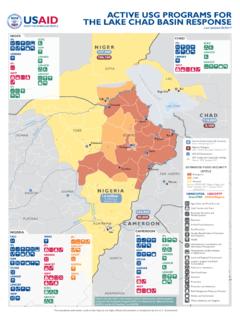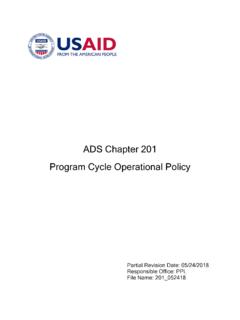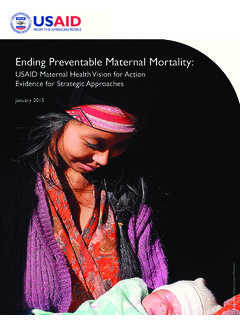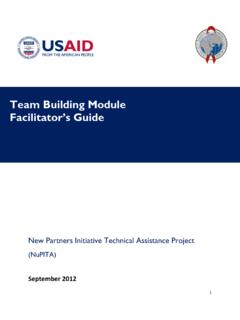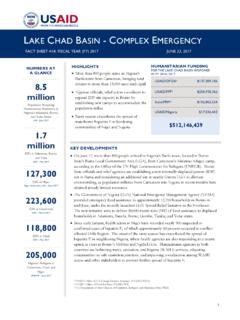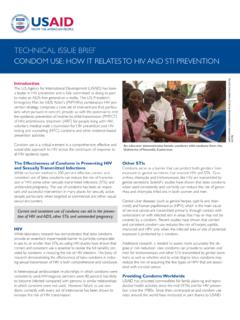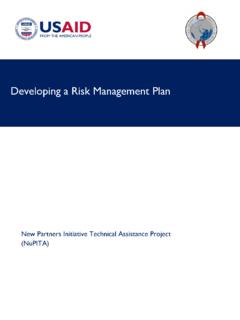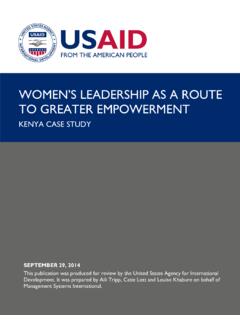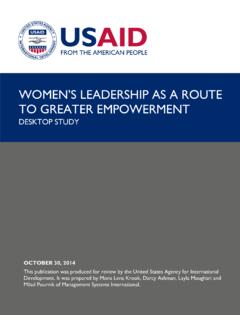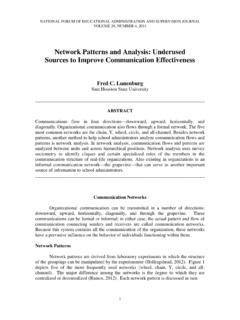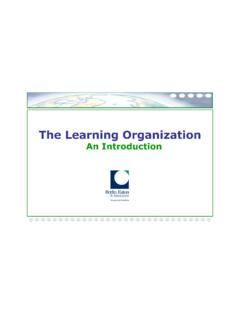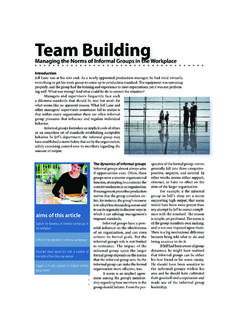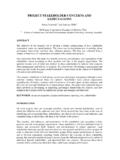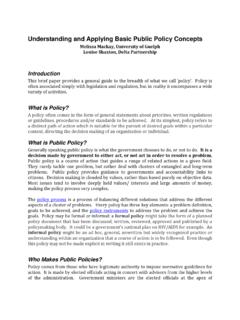Transcription of Online and Offline Activism in Egypt and Bahrain
1 Online and Offline Activism in Egypt and Bahrain Research and Innovation Grants Working Papers Series April 29, 2016 08 Fall Online and Offline Activism in Egypt and Bahrain Research and Innovation Grants Working Papers Series April 29, 2016 James Fowler Zachary Steinert-Threlkeld University of California, San Diego TABLE OF CONTENTS EXECUTIVE SUMMARY ..1 INTRODUCTION ..2 A. Research Questions .. 2 B. Summary of Findings .. 3 OVERVIEW ..4 A. Selection of 5 B. Exploring Online / Offline Social Movements .. 6 C. Defining Terms .. 8 D. Identifying Tools and Strategies .. 10 METHODOLOGY .. 10 A. Introducing the Digital Case Study .. 10 B. Machine Learning and SNA.
2 13 C. Ethnographic Analysis .. 23 CASE STUDY: Egypt .. 27 A. Movements .. 29 A. Mass Mobilization .. 33 B. Information Dissemination .. 44 CASE STUDY: Bahrain .. 58 A. Movements .. 60 B. Mass Mobilization .. 64 C. Information Dissemination .. 72 83 REFERENCES .. 87 MESSAGE FROM THE DIRECTOR The DRG Center of Excellence is pleased to share Online and Offline Activism in Egypt and Bahrain . This publication was produced by USAID in partnership with the Institute of International Education as part of the Research and Innovation Grants Working Papers Series. The Strategy on Democracy, Human Rights and Governance1 reaffirmed USAID s commitment to generate, analyze, and disseminate rigorous, systematic, and publicly accessible evidence in all aspects of DRG policy, strategy and program development, implementation, and evaluation.
3 This paper, along with the others contained in the series, makes a valuable contribution to advancing this commitment to learning and evidence-based programming. This series is part of USAID s Learning Agenda for the DRG Sector, a dynamic collection of research questions that serve to guide the DRG Center s and USAID Field Missions analytical efforts. USAID seeks to inform strategic planning and project design efforts with the very best theory, evidence, and practical guidance. And through these efforts, the Learning Agenda is contributing to USAID s objective to support the establishment and consolidation of inclusive and accountable democracies to advance freedom, dignity, and development. The research presented in this paper examined the activity of formal and informal organizations and identity groups in the 2011 protests in Bahrain and Egypt .
4 The University of California, San Diego s findings suggest that although activists use of social media tools did play important roles in the protests, including using Twitter to grow a local Online community, most of the activists work occurred Offline and was led by formal NGOs using more traditional organizational methods. I hope you find this research enlightening and helpful. As the DRG Center s Learning Agenda progresses, we will continue our effort to bring forward the latest in relevant social science research to important constituencies for our work, particularly our DRG cadre and implementing partners, but also others. I invite you to stay involved as this enriching, timely, and important work proceeds. Neil Levine, Director Center of Excellence on Democracy, Human Rights, and Governance US Agency for International Development 1 (1).
5 Pdf ACRONYM LIST ACT Appropriate Techniques for Development Center API Application Programming Interface BCHR Bahrain Center for Human Rights BFS Breadth-First Search BYSHR Bahrain Youth Society for Human Rights CSO Civil Society Organization DCHA USAID s Bureau for Democracy, Conflict, and Humanitarian Assistance DFG Democracy Fellows and Grants Program DRG Center USAID s Center of Excellence on Democracy, Human Rights, and Governance EIPR Egyptian Initiative for Personal Rights GCC Gulf Cooperation Council HMLC Hisham Mubarak Law Center ICT Internet and Communications Technology IIE Institute of International Education MENA Middle East and North Africa NB Na ve Bayes NLTK Natural Language Toolkit NGO Non-Governmental Organization REST API Representational State Transfer Application Programming Interface RTs Retweets SCAF Supreme Council of the Armed Forces SMN Social Media Network SMS Short Message Service SNA Social Network Analysis SVM Support Vector Machines UCSD University of California, San Diego University of California.
6 San Diego USAID/DCHA/DRG Working Papers Series 1 EXECUTIVE SUMMARY To the international community watching mass public protests unfold across the Middle East in the first half of 2011, mobile, internet-dependent platforms such as Twitter, Facebook, and other social media tools appeared to play a prominent role in mobilizing the protests and organizing focal points of protest activity. Using social media, individual activists posted calls for action, reported live from protest scenes, and reacted to relevant breaking news, allowing the international, regional, and local communities to watch the protests unfold in real time, with the story narrated by the protesters themselves. But how crucial were social media to engaging, inspiring, and organizing the protests?
7 How did activists use social media tools? What other strategies were used effectively? What role did formal, registered NGOs play? Through an Innovation and Research Grant funded by USAID s Center of Excellence on Democracy, Human Rights, and Governance under the Democracy Fellows and Grants Program, a research team led by the University of California, San Diego (UCSD) examined the activity of six formal and informal organizations and identity groups, three in Bahrain and three in Egypt , that were engaged in the 2011 protests in each country. The team conducted ethnographic interviews in Bahrain and Egypt in late 2014 with 30 activists who had been associated with these six movements in 2011, and compared that data with quantitative analysis of the Twitter behavior, during the short period of greatest protest intensity in 2011, of 19 activists also associated with these groups.
8 UCSD s findings suggest that although activists use of social media tools did play important roles in the 2011 protests in each country, most of the work to mobilize, organize, and manage the protests occurred Offline and was led by formal NGOs and their staff working with individual activists affiliated with informal organizations and identity groups: In 2011 when the protests began, Bahrain and Egypt had low levels of social media use: in Bahrain , although 75% of the population used the Internet, only 24% used Facebook and 3% used Twitter; in Egypt , 39% used the Internet, 10% used Facebook, and 1% used Twitter. Offline community organizing techniques spreading information via direct face-to-face contact, text messages, or phone calls and sharing resources and determining strategy in the offices of registered NGOs drove mobilization and information dissemination once the protests were underway.
9 Once the protests started, activists used Twitter primarily via mobile devices, suggesting that Twitter provided documentation of protest events, if not a forum for mobilization and organization. Activists also used Twitter as a foil for authorities attempting to repress protest activity posting on Twitter where activity would occur and then coordinating via phone calls, text messages, and face-to-face communication to move the activity to another location. Activists affiliated with these six groups and with formal NGOs did interact Offline during the protests; however, this Offline coordination did not carry over into Online space. Activists who used Twitter during the 2011 protest period had low levels of Online interaction with protesters who were also on Twitter, and activists efforts to coordinate protest communication around common hashtags gained little local traction.
10 Activists had substantial Online interaction with international Twitter networks, suggesting that their main audience was international. However, the Twitter use during the protests did grow a local Online community: the density of activists local Online networks increased significantly in both Bahrain and Egypt after the 2011 protest periods. University of California, San Diego USAID/DCHA/DRG Working Papers Series 2 INTRODUCTION In this report, we explore the ways in which six social movements in Egypt and Bahrain used Online and Offline Activism to mobilize political activity during the 2011 protests. Information and communication technologies (ICTs) the Internet and social media platforms, in particular are widely perceived to have played an important role not only in disseminating information, imagery, and updates about the unfolding protests of the Arab Spring but also in helping to mobilize them.
